Spinnerbait Tips for Bass Fishing in Mexico
(or anywhere else that trophy bass abound in
heavy cover)
The spinnerbait is the second most popular lure in all of
Mexico.
Only the highly snag-proof Texas rig is more popular than the
spinnerbait.
The spinnerbait is surprisingly snag-proof itself.
The strong wire arm acts as fantastic snag protection for the
spinnerbait hook.
The incredibly snagless spinnerbait can be fished through
heavy cover that would snag other kinds of lures.
Crankbaits, topwater, lipless, swimbaits are all other popular
lures in Mexico - but none can not go in heavy cover where the
spinnerbait can go.
So that's why the spinnerbait is #2 favorite in Mexico (after
the Texas rig), because a spinnerbait can go anywhere a bass can
go, even into the heaviest cover.
The All-Around Favorite Spinnerbait in Mexico is...
Half white / half chartreuse skirts or pure 100% white skirts
are the two most favorite colors in Mexico.
Half chartreuse / white or all white spinnerbaits work
everywhere all the time under most conditions across Mexico and
across the world.
Many anglers may say they prefer the all white in relatively
clearer water and opt for the chartreuse / white in relatively
darker water.
Traditionally, anglers on all Mexican lakes favor 1/2 oz and
3/4 oz spinnerbaits with two medium size Willow blades. One
silvery nickel blade in front, and a gold blade in back. By
medium size blades, we mean a #4 front Willow and a #5 back
Willow. The double Willows are the most popular in Mexico and
worldwide.
In USA, there are some smaller 1/4 oz or 3/8 oz spinnerbaits,
but these are often too small and the wire arms are too thin for
Mexico. Bass grow big in Mexico and they want a big spinnerbait!
You will catch many, many bass - big and small - on 1/2 and 3/4
oz spinnerbaits in Mexico.
Therefore, on bright, clear days (most fishing days are bright
and clear) the number one most popular combination in all of
Mexico is... either a 1/2 or 3/4 ounce with double Willows -
front silver #4, back gold #5 and a half chartreuse / white or
100% white skirt.
Second most popular in Mexico is a small front Colorado (#3
gold) and a back Willow (#5 silver nickel) and a half
chartreuse/white or 100% white skirt. Indeed, 90% of all
spinnerbaits in the world are one of those two configurations: 1)
double Willows, or 2) small Colorado with a Willow.
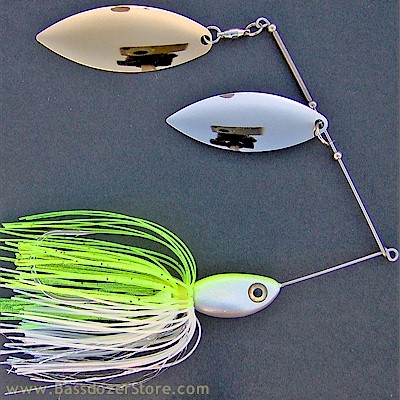
Double Willow blade spinnerbaits are more popular than all other
blade pairs.
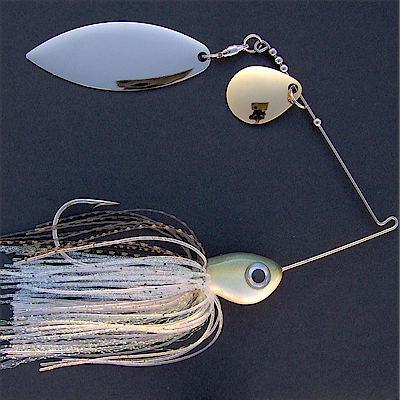
A small front Colorado with a back Willow is the second most
popular blade pair.
Truly Trophy Bass Prefer...
One other size - the bigger 1 oz spinnerbait is recommended
for the real trophy bass.
In Mexico, the 1 oz is not used quite as much as the 1/2 or
3/4 oz size.
What makes the 1 oz special for trophy bass is the 1 oz can
support bigger blades sizes - like a 5-1/2 Willow in front and a
#6 or #7 Willow in back.
Smaller (1/2 and 3/4 oz) can not truly support the bigger
blades. Only the 1 oz can carry bigger blades.
So the 1 oz with bigger blades is truly the special trophy
bass spinnerbait. It is a bigger spinnerbait than usual - for
bigger bass than usual.
Biggest Bass Spinnerbaits on Planet Earth...
Some of the very biggest spinnerbaits that you are able to
cast for bass are 1-1/2 ounces - but they are relatively rare.
Almost nobody in Mexico uses the 1-1/2 ounce size - but they
should. Reason is the 1-1/2 can support larger size #7 and #8
Willow blades.
Smaller spinnerbaits - 1/2, 3/4, 1 oz - can not support the
very big blades like the 1-1/2 oz can.
#7 and #8 are the very biggest size Willow blades on the
planet, and #7 and #8 blades on 1-1/2 oz spinners will catch the
very biggest bass on earth - many of which are all swimming
around in Mexico right now!
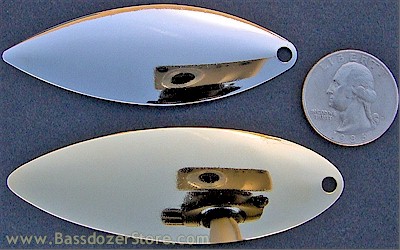
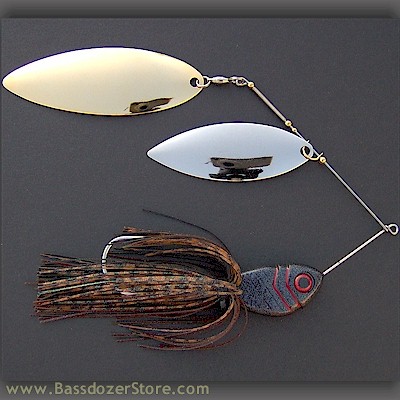
1-1/2 oz spinnerbait supports the biggest blades for the biggest
bass.
Very Best Days and Times for Spinnerbaits
I have found my best success on spinnerbaits is when it's
windy. Whenever the wind makes a ripple or "chop" on
the water, spinnerbaits are best.
Also overcast, cloudy days, rainy days or early in the morning
or late in the evening when the light is dim (low light) are best
times for spinnerbaits.
Best Colors for Dark Times of Day - and for Dark Water
Keep in mind, soft plastics in dark colors - watermelon, green
pumpkin, black soft plastics work all the time.
Just like dark plastics, dark spinnerbaits can work at any
time too.
Especially where the water color is dark, use dark color
spinnerbaits.
Also at dark times of the day - very early in the morning,
very late in the evening and at night, dark color skirts and
heads painted dark are at their best:
- black
- black red
- black blue
- june bug (dark purple)
- dark green pumpkin
- watermelon red
Under dark conditions, you can try dark blades to match dark
skirts:
- copper blades
- painted black blades
- silvery nickel and gold blades go fine with dark spinnerbaits
too
Also remember that the plentiful tilapia, crayfish and other
small fish are dark. That means dark spinnerbaits can work
absolutely anywhere just about anytime that bass feed on small
dark baitfish and crayfish.
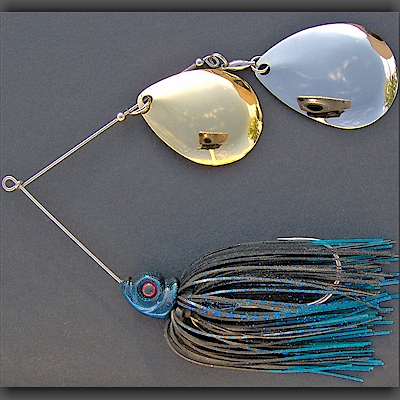
Dark color skirts with loud, thumping Colorado blades work in
dark water, in low light very early or very late in the day, at
night or in cold water.
Seasonal Spinnerbait Tips
In general, seasonally:
- Spring and Autumn: Bolder, brighter, more colorful
spinnerbaits (like fire tiger or 100% chartreuse) are good for
spring and fall when bass are more aggressive. In spring, bass
are more aggressive to protect their nesting areas. In fall, bass
are aggressive in order to impulsively feed more to gain fat to
last them through the winter slow-down in metabolism. This is why
spring and fall fishing can be the best times, because bass act
more aggressive and are less cautious about what they bite then.
- Summer: Bass do not have the spawning aggression or
the fall feeding aggression in summer. This is when the water is
hottest and bass metabolisms are at their highest and sharpest in
summer, making bass more alert and cautious. More neutral, less
flashy, more subtle "finesse" colors and smoother, more
fluid Indiana blades are good choice in summer.
- Winter: Darker colors (think black) and loud, thumping
Colorado blades tend to be good choices in winter or when the
water temperature is cold and bass metabolism slows down. Use
slower retrieve speeds with more pauses on the bottom in winter
than other seasons too. The thinking behind this is the darker,
slower, heavier beat of the Colorado spinnerbait makes a more
deliberate target for the chilly winter bass. Even in Mexico,
bass metabolism slows down in the little bit colder water in
winter.

Smooth Indiana blades and neutral color "finesse"
spinnerbaits work in hot summer.
However, there are no real rules for spinnerbaits. Some kind
of spinnerbait will work every day under all possible conditions.
If you are willing to experiment with different blades,
different skirts, different retrieves and different fishing
locations - you may be able find the "lucky spinnerbait
combination" on any day.
Fact is, on every fishing trip I've made (since I started
counting this) for over three years now. I have caught at least
one to many good bass on spinnerbaits every trip. It is not
always easy to find out the "lucky spinnerbait
combination" but it isn't impossible either. Just try a few
different ones until you start to get bites. Bass will bite one
kind or another of spinnerbait every day.
Try Different Blade Shapes Every Day
There are three basic different blade shapes. Actually, there
are more than three, but these are the three most common:
- Willow: Long and slender shape, the most popular
worldwide. Many anglers only use Willows.
- Colorado: Very round shape, rounder than a soup spoon.
Emits strong vibrations. Good for dark water, at night, when
water is cold.
- Indiana: Teardrop shape. Not as popular as Willow
or Colorado. Very smooth spinning blade. Good for clear water,
bright, sunny days, when hot water in summer or when bass are
more alert and cautious.
Many days, bass may hit all three blade shapes. On some days,
they may seem to want one shape more than the other two. It is
often unpredictable. You have to fish day-to-day to keep up with
what's happening out on the water. If you can not be on the water
day-to-day (most of us cannot), then "trial and error"
is the only way to try to find what blades seem best each day.
Just try them.
Most anglers only use double Willow blades. However, the
angler who experiments and tries all three (Willow, Colorado,
Indiana) ever day, he or she will have more luck and catch more
bass over the season. The angler who only uses Willows will have
less luck and catch less with spinnerbaits over the season.
Try Single and Double Blades Every Day
Most anglers only use double blades.
Single blades are not used as much.
It does not sound as if it should be correct, but it's true
that a single blade vibrates harder and throbs stronger than
double blades.
And a single blade can be retrieved more slowly at slower
speeds than double blades.
So anglers should always experiment with:
- single Willow blades
- single Colorado blades
- single Indiana
- double Colorados
- double Indianas
- double Willows (the most popular)
- small Colorado with Willow (second most popular)
There is really no way to predict what blade combination will
work when. You just have to try them and see if bass want them or
not. Overall, the angler who shows bass different blade
combinations, that angler will have more luck and catch more bass
over the course of the season.
Although they are not used a lot, painted blades can also
work. For example:
- two white blades
- one white blade and one chartreuse blade
The angler who tries painted blades will have more luck and
catch more bass over the season.
Shallow Water
Spinnerbaits are mainly used in shallow water.
"Ticking the tops" with a spinnerbait is a phrase
used for when bass are situated up high near the water's surface
in the tops of flooded brush, emergent tree limbs or underwater
vegetation.
In these situations, a relatively lighter 1/2 oz spinnerbait
is used to "tick" or bump the tops of the brush, trees
or aquatic weeds. "Ticking" the wood and weeds triggers
bass to hit. The 1/2 oz size is best for this since it is lighter
and bounces more easily off brush, limbs or stalks without
snagging. Heavier 3/4 and 1 oz will snag more frequently when
"ticking the tops" like this.
On the other hand, when you have to cast far distances and
"cover the water" on shallow flats however, in those
cases, the 3/4 and especially the 1 oz cast further, more
accurately and cover more water than the 1/2 oz.
In many good fishing spots on Mexican lakes, the brush or
trees or weeds may be so thick, that it seems impossible to get a
boat back where the fish are feeding. That's the time for you to
break out the big 1 oz spinnerbait. The 1 ounce is the best size
for casting far back into dense brush where your boat can't get
in. A 1 oz spinnerbait will let you cast way back there and reach
fish where the boat can't go. A lighter 1/2 or even 3/4 oz
spinnerbait would not reach that far back into the cover to get
to the fish at times.
Deep Water
Spinnerbaits work well in deep water also (10 to 30 feet
deep).
Unfortunately, most anglers do not use spinnerbaits deep. It's
hard to do.
Fishing spinnerbaits deep is the sign of a true expert.
It's important to keep a deep spinnerbait near the bottom. If
it isn't near the bottom, your chances for a bite are poor.
Many anglers know that a Texas rig, for example, in deep water
must be kept on the bottom. Likewise, a spinnerbait must be kept
on or near the bottom in deep water.
Keeping a spinnerbait near bottom in deep water means you must
give it plenty of time to sink, reel very, very slowly so it
stays deep, and stop reeling every 20 feet of the retrieve so the
spinnerbait can sink again and again (every 20 feet) until it
gets back to the boat.
This is similar to how you keep a Texas rig near the bottom in
deep water, except the spinner blades (like a helicopter) make
the spinnerbait lift faster and higher than a Texas rig - so you
need to reel slower and pause more often to keep the spinnerbait
near bottom. The good part about pausing often is that many bass
will bite the spinnerbait when you stop reeling to let it sink.
They hit the spinnerbait as it falls.
There is a special name for hugging the bottom with a
spinnerbait in deep water. It is called "slow rolling"
which means to use the spinnerbait deep and slow, near the
bottom.
Another special deep water tactic is to "yo-yo" or
"yoyo-ing" the spinnerbait in deep water. This is to
lift the rod tip to lift the spinnerbait a few feet off the
bottom, then let it fall to hit bottom again. Simply lift, fall,
lift, fall and "yoyo" the spinnerbait all the way back
to the boat. Most bass will hit when the spinnerbait falls or
when the spinnerbait pauses and lays momentarily on the bottom.
Don't Forget Trailer Hooks
Prime spinnerbait spots in Mexico usually have thick cover
that makes it more difficult to fish with a second add-on trailer
hook. In general, you will get a few more snags - but land a few
more bass as well - with a trailer hook.
Truth is, most anglers will try to get away without using a
second trailer hook since it's an extra piece of equipment to
take care of. Most anglers would rather not have to hassle with
it. Some days, it may be fine not to use trailer hooks. However,
there are two situations to be aware of when trailer hooks are especially
wise to use, or put another way, it would be foolish not
to use them when:
- Fish seem to be "striking short" and missing the
primary hook, add a trailer hook.
- Fish are jumping right away and more than usual and you lose
them when they jump, add the second trailer hook and they will
not be able to jump off so quickly and easily.
As shown below, a trailer hook is simply a second hook with a
small plastic tube used to attach it to your primary spinnerbait
hook. You insert the second hook's eye inside the piece of
tubing, and then insert the point of the primary spinnerbait hook
through the tubing and therefore through the eye of the second
hook, forming a second "trailer hook" on your
spinnerbait. You will catch more fish with the second hook. The
negative aspect of the second trailer hook is it snags more - but
when fish are striking short or jumping off the hook - a trailer
hook will help you catch more fish.
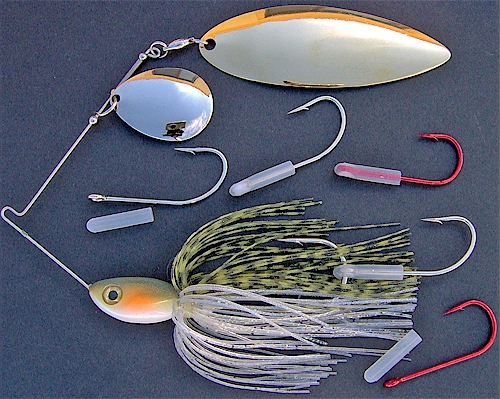
What About Trailer Baits?
There are actually two different kinds of trailers that can be
added to a spinnerbait - trailer hooks (see above) and then,
there are trailer baits.
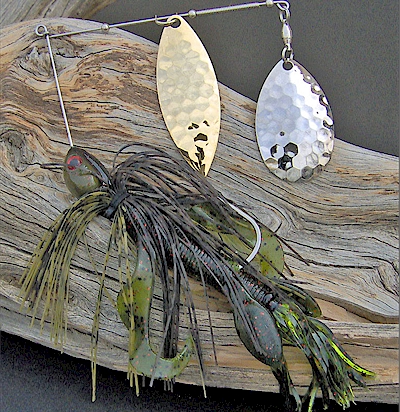
Green pumpkin/olive spinnerbait with watermelon red soft plastic
trailer bait.
Trailer baits can be single tail grubs, double tail grubs,
curly tail worms and other soft plastic baits can be threaded
onto the hook under the spinnerbait skirt to add more size and
more action to a spinnerbait. Usually, with a white or half
white/chartreuse spinnerbait, try adding a white or chartreuse
soft plastic trailer.
Be aware that - and this is important - there are
unpredictable days when bass only want a spinnerbait with a
trailer bait added on it. So if fishing is slow with a standard
spinnerbait, try adding a trailer bait to see if it helps you
catch more bass. Some days spinnerbaits with trailers will catch
many more bass than spinnerbaits without trailers.
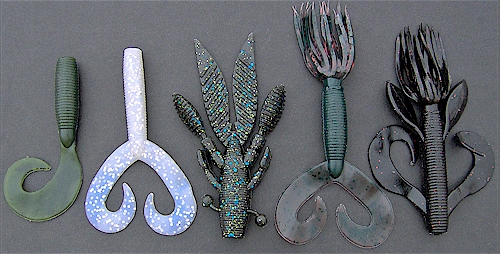
Spinnerbait trailer baits. Thread on hook up under spinnerbait
skirt.
Use One or the Other but not Both. Typically, you would
add one or the other (either add a trailer bait or add a trailer
hook). It is not usual to add both a trailer bait and a trailer
hook at the same time. Trailer baits and trailer hooks are not
both used together because they create too much trouble - too
much maintenance to fix them. With both, you have to stop and fix
almost every cast. Worst of all, they can foul on each other
when you cast and waste a lot of good casts that way. So that's
why it is easier and less trouble to use one or the other - but
not both.
Actually, the most trouble-free way is not to use either one -
just use the spinnerbait with no trailer add-ons. But sometimes
the bass need either the trailer hook (if they bite short or jump
off often) or they need the trailer bait to sweeten the lure and
to make it a bigger, more active and appealing bait.
Rods, Reels, Lines for Spinnerbaits
-
General Purpose Heavy Cover Outfit
A medium heavy baitcasting rod, either 6'6" or 7'0"
with 50 lb braid is a super set-up for heavy cover. The Falcon
Expert Medium Heavy (in either 7'0" or 6'6") is a good
example - but there are many other medium heavy rods that will
work well.
A light but powerful baitcasting reel is best. You want what's
called a "low profile" reel - the lower the profile and
the smaller the reel, the better. A number of the newest,
smallest reels on the market are incredibly powerful and handle
50 lb braid with no problem. A few examples include Daiwa Sol,
Daiwa Fuego and Abu Garcia Revo. They have all the power you'll
ever need in a small package.
A small low-profile reel fits right inside the palm of your
hand. That makes it more comfortable and less tiring to fish
spinnerbaits all day. There is no advantage to a bigger,
harder-to-palm reel.
Braid like PowerPro - in 50 lb test - is best for this heavy
cover spinnerbait set-up.
This strong rod and heavy braid is required in heavy cover,
but there is not enough stretch in the line - and not enough soft
"give" in the rod (with 50 lb braid) to help keep a
fish hooked when it jumps. That is the moment when you lose most
spinnerbait bass - during the jump. So you need to keep the rod
tip low to the water at all times, to help prevent the fish from
jumping. If you can keep a bass from jumping, you probably will
not lose it.
A bass may jump at any time - but a high percentage of jumps
occur right away in the first few seconds after the bass bites.
Another high percentage of jumps occur at the end of the fight,
when the bass gets close to the boat, it jumps. Jumps in the
mid-section of the fight are less common. So pay close attention
at the beginning and end of the fight, because that is when most
bass jump off the hook. Keep the rod tip down near the water to
discourage them from jumping at al times with spinnerbaits.
When fishing in areas without heavy cover, the same rod with
30 lb test braid or 17 to 20 lb test fluorocarbon or mono can be
used, and these lighter lines actually let the same rod behave
softer, bend and "give" more, plus mono and fluoro have
much more line stretch. Line stretch helps keep a jumping bass
pinned to the spinnerbait better than braid. Mono actually
stretches more than fluoro.
-
Spinnerbait-Specific Outfit
There are many rods you will see that are rated or designed
exclusively for spinnerbaits. You can see them in rod
manufacturer's catalogs, on web sites or in popular mail order
tackle catalogs, you will see many different "spinnerbait
rods." These rods are described as being specially-made with
rod actions just for spinnerbaits. Unfortunately, many of these
are too soft and bend too much for fishing in Mexico. In Mexico,
the fish are bigger and the cover is heavier than can be handled
by most spinnerbait-specific rods you will see in catalogs or on
the Internet.
There are also areas in Florida and Texas (for example) where
the fish are bigger and the cover's far heavier than normal. Many
"spinnerbait-specific" rods are made too light for all
these places, including Mexico.
Your best choice if you want to get a spinnerbait-specific rod
is to visit a good local pro tackle shop in Mexico where the
owners and sales staff who work there are expert bass anglers.
They will be able to recommend, tell you why, and sell the best
rods to use specifically for spinnerbaits.
When fishing in areas without heavy cover, in more open water
or for deep slow-rolling, one of these spinnerbait-specific rods
may have better lure action, better feel of the lure, can be used
with mono or fluoro, and will help prevent jumping fish from
getting off the hook as easily. However, this rod and line may be
too light for heavy cover.
So to be well equipped for all spinnerbait situations, you
would ideally want two rods:
- a medium heavy with heavy braid for heavy cover, and
- a local pro shop's recommended spinnerbait-specific rod with
lighter braid or mono or fluoro for areas without heavy cover.
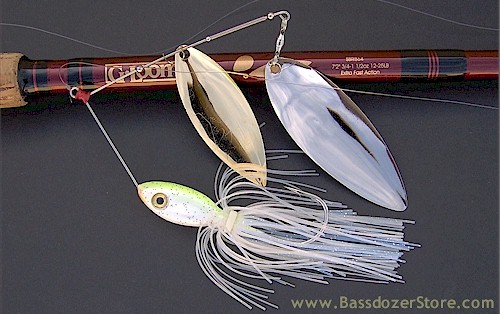
Spinnerbait-specific rods, like this powerful G. Loomis model
#SBR864 can be a good idea - but check with your local pro shop
first.
And that's all about spinnerbaits for Mexico!
Buena Suerte! (means
"Good Luck!" in Mexico).
|
